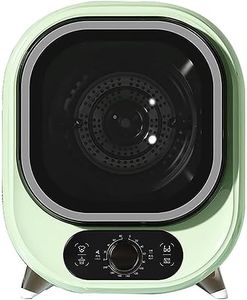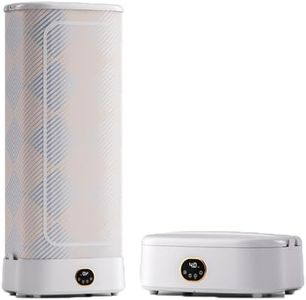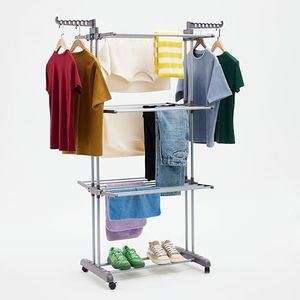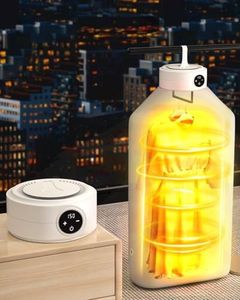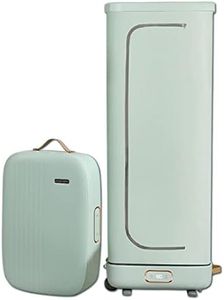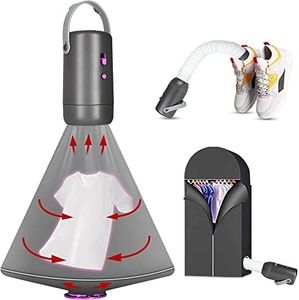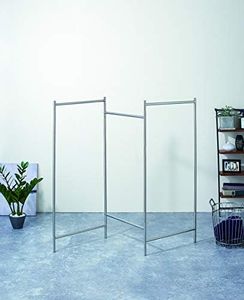We Use CookiesWe use cookies to enhance the security, performance,
functionality and for analytical and promotional activities. By continuing to browse this site you
are agreeing to our privacy policy
10 Best Clothes Dryers
From leading brands and best sellers available on the web.By clicking on a link to a third party's website, log data is shared with that third party.
Buying Guide for the Best Clothes Dryers
Choosing the right clothes dryer can make laundry day much more efficient and stress-free. When picking a dryer, it’s important to consider your living situation, the size of your household, your laundry habits, and the available space and connections in your home. Thinking carefully about what features matter most to you will help you find a dryer that suits your needs and works reliably for years to come.Dryer Type (Vented, Condenser, Heat Pump)The type of dryer refers to how the machine removes moisture from your clothes and where that moisture ends up. Vented dryers expel hot, moist air through a hose to the outside of your home, needing a suitable outlet. Condenser dryers collect moisture in a tank, which you need to empty, or drain it away. Heat pump dryers are more energy-efficient and gently dry clothes by recycling heat, but usually take longer. Think about your home’s layout: if you have a window or wall vent, a vented model could be simple; if not, a condenser or heat pump dryer is often easier to install. If you prioritize energy savings, look into heat pump models.
CapacityDryer capacity is measured by the maximum weight of dry laundry it can handle in one go. Small capacities (around 4-6 kg) work best for single people or couples, while medium (7-8 kg) suits small families, and larger capacities (9 kg and up) are ideal for big households or if you wash lots of sheets and towels. When choosing, consider how often you do laundry and the size of your typical loads—don't get a bigger drum than you need, since smaller loads in a large dryer waste energy, while overfilling leads to poor drying.
Energy EfficiencyDryers use a lot of energy, so their efficiency matters both for the environment and your bills. Most have an energy rating label: the higher the rating, the less electricity used per cycle. Standard dryers use more energy than heat pump or condenser types. If you want to save on long-term operating costs, focus on models with high energy ratings. Assess how much you’ll use the dryer each week to decide how much efficiency matters to you.
Sensor vs. Timed DryingSome dryers come with moisture sensors that stop the cycle when your clothes are dry, preventing over-drying and saving energy. Timed dryers let you set how long the machine runs, regardless of how dry the clothes get. Sensor drying is generally gentler on clothes and helps avoid shrinking but can be more expensive. Think about whether you want to ‘set and forget’ your laundry, or if you prefer more manual control.
Programs and SettingsModern dryers offer different programs for things like cottons, synthetics, delicates, sportswear, or quick-dry cycles. These help match the drying process to fabric types, making it safer for your clothes. If you have a wide range of laundry types, or want specific cycles (like anti-crease or refresh), check the program options carefully. If your laundry needs are simpler, a few basic settings may be enough.
Size and Installation RequirementsDryers come in different sizes, both in terms of drum capacity and physical dimensions. It’s important to measure your available space—including doorways and installation spots—before buying. Some dryers can be stacked on washers, saving floor space, while others need to sit side-by-side. Also check for necessary power and vent connections. Consider your laundry area’s layout and how easily you want to access the dryer.
Noise LevelDryers can be noisy, especially vented types. Noise levels are measured in decibels, and lower numbers mean quieter operation. If your laundry area is close to living spaces or bedrooms, a quieter dryer may be a priority. Otherwise, noise might not matter as much, especially if your laundry’s out of the way.
Filter and MaintenanceAll dryers need regular cleaning to work efficiently and safely. This includes emptying lint filters and, for condenser and heat pump dryers, emptying water tanks and cleaning condenser units. Some models make these tasks easier with accessible filters and reminders. When comparing options, check how easy it will be to maintain in everyday use.
